Tomas Lindahl
Biographical
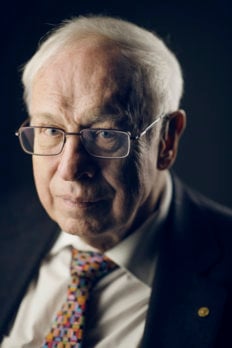
Asked to reflect on my background, I realise that the conditions under which I grew up were very different from those that young scholars encounter today. I was raised and educated in post-war Stockholm, Sweden, where I was born on 28 January 1938. My parents lived on one of the large islands in central Stockholm called Kungsholmen, but moved to the western suburb of Bromma within a few years, with a rented summer cottage in the adjacent archipelago. I obtained my early training in Stockholm and retain many friends there.
My father Robert was a businessman with a deep interest in literature (Fig. 1). He had spent several years in France as a young man, and there he acquired a life-long enthusiasm for haute cuisine; he was an excellent cook himself. My mother Ethel (Fig. 2) became a university administrator and later moved on to a similar post in the Swedish parliament. She was greatly helped in that venture by fluently speaking six foreign languages, a talent I unfortunately have not inherited. Neither of my parents had any background in natural sciences, but they nevertheless always gave me unconditional support.
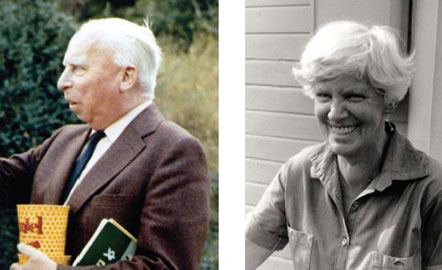
An important factor in our family life was the close relationship between my father, his sister and his three successful brothers. They all lived in Sweden and saw each other regularly. My oldest uncle, Erik, was a professor of economics in Uppsala, where he was a main teacher of Dag Hammarskjöld. Uncle Helge, chairing the association of Stockholm lawyers, had a pleasant house in the Stockholm suburb Bromma, where my parents also moved. My aunt Ingeborg became a high school teacher in French. The two youngest brothers, Gunnar and my father, were particularly close, and uncle Gunnar’s constructive advice to my parents was very influential on the early life of me and my younger brother, also called Gunnar. Uncle Gunnar was an eminent surgeon who became the Director of a large hospital in western Sweden at Torsby. He collected modern French art. On his excellent advice, my brother and I were given Christmas presents when we were young boys in the form of colourful original lithographs by French artists such as Maurice Estève. Seeing these beautiful abstract pictures for most days of my life has been helpful to gain some understanding and love of fine art, although I am a hopelessly incompetent draughtsman.
As a younger teenager, I developed an interest in botany and spent several summers bicycling around the large, limestone-rich island of Gotland in the Baltic, searching for rare wild orchids.
High school (gymnasium)
I was fortunate with my high school education in that our family lived close to an excellent upper secondary school, Bromma Läroverk (now Bromma gymnasium), where I was a student for most of eight years (Fig. 3). At that time, the Bromma school had teachers of outstanding calibre, with Fredrik Ehrnst (mathematics) and Karin Brandt (chemistry) as well as the Headmaster himself (Dr Gustaf Iverus), being especially impressive and helpful.
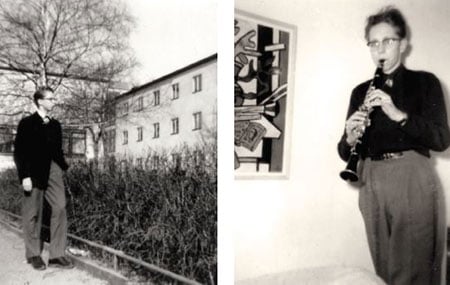
Many pupils at Bromma were also exceptional. My class of 30–35 co-educated individuals included Björn Svedberg, later chief executive of the large L M Ericsson telecommunications company (now Ericsson), and Olle Orrje, a talented engineer, mathematician, poet, jazz musician and expert on high jump. A close friend at that time was also the late author and essayist Torsten Ekbom, although we met at the Kungsholmen rather than Bromma school.
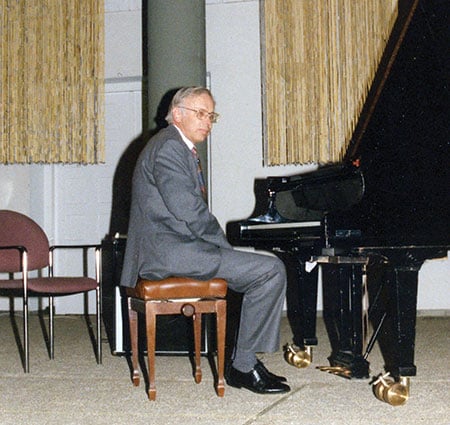
I was not particularly talented in sports, although I enjoyed long-distance running before it became fashionable, but I spent much more time on music. I played the piano, both classical music and jazz, and became a good sight-reader. But I did not practice enough; I could get through most Beethoven sonatas but not adequately perform the brilliant romantic repertoire by Chopin and Schumann (Fig. 5). Debussy became a long-term favourite. I also played jazz music (Fig. 4), a common talent among students in Bromma, initially in New Orleans and dixieland style on the clarinet or soprano saxophone, but gradually turning to modern jazz on the piano, with Bud Powell and Thelonius Monk as particular sources of inspiration. Since jazz is dependent on collective improvisation, I made many inspiring friends that way, and I have been glad to have heard from several of them, after many years, in connection with the recent publicity about my Nobel Prize. My short career in jazz ended when I entered medical school; in Sweden there was still a general military draft system at that time. In order not to delay medical training, initial military service of three months each summer for three years was done by future doctors. So, I could hardly practice music in the summer, whereas my friends became more advanced, and obviously I was left behind in musical accomplishment. It was no comfort at all that I instead had become trained to use pistols, guns and machine guns, and throwing grenades and bombs.
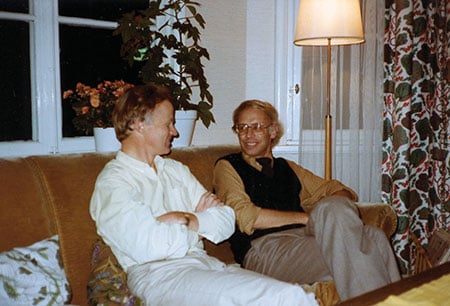
Our family was typically middle-class, not rich, but because Sweden is a hightax society that provides free education, my parents never had to pay school fees for me or my brother either in good high schools or in medical school (Fig. 6). Admission to sought-after university programmes such as medicine depended on excellent school marks, whereas interviews, fees or private funding did not occur. When I later considered giving up my medical studies to concentrate on scientific research, which of course was a very risky future, it seemed important that I had not already taken out substantial student loans.
Karolinska Institute
With the strong encouragement of my uncle Gunnar, I decided to apply to the medical school in Stockholm, called Karolinska Institute (Fig. 7), after graduating from high school. I had adequate but not outstanding school marks; I prefer to blame this result on a lack of focus because of too many competing interests. But the important outcome was that I scraped into medical school.
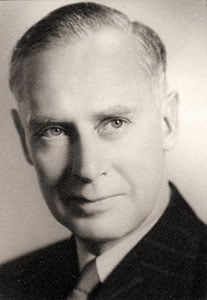
After initial studies in anatomy, histology and physiology, I became especially excited about biochemistry and bacteriology. On the other hand, an introductory course in surgery demonstrated clearly that I was impractical and incompetent in this important speciality.
At that time, the Department of Bacteriology started a new initiative to recruit medical students who might consider taking a one-year break from their medical studies to attempt a serious basic research project, guided by an experienced scientist on the faculty. I was intrigued by this prospect and was accepted, with very little competition for the post. This became a new departure, although it took many years before the Swedish Army stopped their annual query if I had completed my training in surgery.
Wine tasting
I never became enthused about academic student life and preferred to interact with my friends in the fields of literature and jazz music, but during my initial medical studies I made an influential new friend, Johan Liljenberg, the son of a Stockholm doctor. Johan had picked up an unusual and esoteric new interest, which was little considered at the time, that is, fine wine. In those days, the Swedish wine and spirits monopoly system allowed this state agency to buy the most superb Bordeaux wines of fine mature vintages for sums that today seem ridiculously low. Still, the public showed little interest. In the Swedish monopoly system, there was a dull-looking catalogue of the 300–400 different wines which could be purchased. Johan and I, and a couple of other friends convinced the biggest food magazine in Sweden, Allt om Mat, to buy a bottle each of all these wines, and we then tasted them over a series of evening sessions. We wrote critical, or positive, comments on each wine as capsule reviews which were then printed with similar typography as the official one. This yearly hard-hitting annotated wine catalogue became a commercial success, and I was sorry to have to give it up many years later due to other, more “serious” interests and moves abroad. For my efforts during those years, I obtained a tiny honorarium, but could order as much wine as needed for all tastings and comparisons of the changing assortment. I particularly recall two red Bordeaux wines from 1949, Château Lafleur (Pomerol) and Château Mouton-Rothschild … Of course, the general public was more interested in whether a certain inexpensive wine was good value for money, or awful, and in the latter respect we were not at all polite in our comments, as you might have expected from irreverent young medical students.
Starting research on DNA
At Karolinska Institute there was a small annex to the Bacteriology Department used by the retired chairman and professor of chemistry, Einar Hammarsten (Fig. 8), and a very small group of his co-workers. Einar was a pioneer in DNA research before it became clear how important this large molecule is. I found him fascinating, with his total absorption in scientific research. His attitude of complete devotion to his main interest reminded me of top musicians. In a typical incidence, Einar explained an interesting problem to me, the beginner, and we went into the large cold room to pick up some reagents. There, he became absorbed with his argument and continued a detailed explanation; it did not occur to him that we could just as well have stepped out of the cold room and continued the discussions outside. He had had the most distinguished students and co-workers in his field in Sweden, e.g. Torbjörn Caspersson, Peter Reichard, Torvald Laurent and Ulf Lagerkvist, but when I got to know him he was to some extent an extinguished volcano. Still, I found him inspiring, a real artist of science. He told me a couple of years later that when the Karolinska campus moved from small premises in central Stockholm to its current location just north of the city, he was given money from the Swedish government for the new buildings. But when the bills later arrived, they could not be paid because Einar had already used the funds to purchase new research reagents and consumables, modern instruments and equipment. When he was seriously admonished by the university administration, he just shrugged his shoulders and said that they might consider sending him to prison.
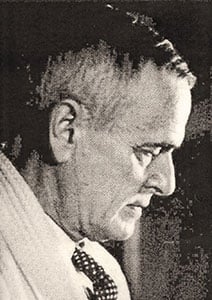
The most interesting research problem I worked on together with Einar was the behaviour of DNA in glycol solution. DNA is best soluble in aqueous solution, and tends to precipitate when an organic solvent such as ethyl alcohol is added. But Einar had observed an interesting exception, DNA solutions could also be made when ethylene glycol replaced water. To pursue this topic further, I was able to learn the technique of bacterial transformation by DNA from an American sabbatical visitor, Professor John Spizizen. Armed with this new method, together with biochemistry, I could show that the biologically active double-stranded structure of DNA survived in a salt-containing 99.8% solution of glycol below 30°C. Such DNA solutions were much less viscous than aqueous solutions. A colleague I later met at Princeton, Dr David Henley, was trained in polymer chemistry and explained to me the concepts of good vs poor polymer solvents. I am surprised that the compact form of native DNA in the “poor solvent” ethylene glycol has not been used more in experimental biochemical work on nucleic acids.
A long visit to the US
Since my work in Stockholm concerned isolation and characterisation of nucleic acids, I was invited to spend a short time at Princeton University in New Jersey, in the group of Professor Jacques Fresco. An important and helpful intermediary was Professor Carl-Göran Hedén at the Karolinska Bacteriology Department. Fresco was interested in preparing large amounts of transfer-RNA to attempt crystallization and structural definition. This visit to Princeton lasted over three years, and I very much enjoyed the friendly and relaxed atmosphere in the Fresco laboratory at the University Chemistry Department. Fresco had been working with the grand old man of nucleic acid chemistry, Professor Paul Doty at Harvard, and he was a dynamic and positive mentor (Fig. 9). He talked a lot, and had not always sifted his new ideas, which made some colleagues underestimate him. However, you quickly learnt not to pay any attention to some of his suggestions, whereas other ideas could be really novel and helpful. One of Fresco’s earlier collaborators apparently had already used the same constructive approach with a positive outcome. He was Bruce Alberts, who later became a very distinguished scientist as well as President of the U.S. National Academy of Sciences.

At Princeton, I collaborated with a young American colleague, Alice Adams, who later became my wife. Together, we produced some interesting work in the Fresco laboratory, in particular the finding that a specific tRNA could be stabilised in two different forms depending on the solvent conditions during the isolation procedure. Only one of these two conformers was biologically active in amino acid acceptance during protein synthesis, which was the first formal proof that the folding pattern of tRNA was biologically relevant. Alice and I later moved to New York and Sweden together, and we have two lovely and successful children, Lena and Nils. But after over ten years, Alice and I drifted apart and separated, which was largely my fault. She ultimately returned to the US with the children and took up a university position in Minnesota.
From Princeton I moved to the Rockefeller University in New York. Since I had been successful in the Fresco group, I obtained a prestigious Helen Hay Whitney postdoctoral fellowship, and I joined the laboratory of Professor Gerald Edelman, a highly intelligent but very tense man, whom I found difficult.
Edelman was awarded a Nobel Prize at that time for his pioneering work on the structure of antibodies. In his group, my ambitious and premature project concerned the genetic and biochemical mechanisms for generation of antibody variability, a complex problem to which I could only contribute in a minor way many years later. Since it seemed possible that genetic recombination events were crucial for antibody variability, I took a biochemical approach and searched for enzymes in lymphoid cells that might be involved in such DNA processing. Some such enzymes of DNA metabolism had just been discovered by others in the bacterium E. coli, an important model system, but it was not known if mammalian cells contained similar factors. I found and characterised the first mammalian DNA ligase and DNA exonuclease, but we did not have the techniques available to attempt to prove their roles in intracellular recombination events. This only became possible with the introduction of DNA cloning and sequencing, years later.
During my biochemical work at the Rockefeller University I was told by a senior colleague and friend in Sweden, Professor Giuseppe Bertani, that the Swedish Natural Science Research Council had advertised an independent research post on the junior professorial level for investigations of the conformation of biologically important macromolecules in solution. I applied, and somewhat to my surprise I was offered the post in competition with a more established scientist from Uppsala. I had had some controversies with Gerald Edelman, but nevertheless he became angry when I told him I was leaving to go back to Sweden for a different job.
Return to Stockholm
At Karolinska Institute, I obtained a small research laboratory of my own within the famous Medical Chemistry department, where Peter Reichard and Sune Bergström were professors. I was successful in obtaining my first research grants from the Swedish Research Council and the Swedish Cancer Society. With this support, I could hire a technical assistant, Barbro Nyberg, who luckily turned out to be a meticulous and talented scientist. I remained in my laboratory at the Karolinska for nine years (1969–1978), and did much of my best work there, which has been described separately in my Nobel lecture. My main research topic was the intrinsic chemical instability of DNA, which suggested that special DNA repair mechanisms must exist to counteract such spontaneous DNA damage.
I had an interesting and serious diversion into tumour virology during this time. The background was that Peter Reichard was promoted to a special research professorship in a separate building at Karolinska after the retirement of the Nobel Prize winner Hugo Theorell. But I had just been able to obtain some additional laboratory space, and my work was going well, so I decided to stay in the Medical Chemistry Department, although I continued to take part in Peter Reichard’s departmental seminars. However, the main emphasis of the important Medical Chemistry Department was research on prostaglandins and bile acids, topics far from my own interests, so Reichard knew I was somewhat isolated there. At that time, Peter was contacted by his good friend at Karolinska Institute, the famous tumour virologist and immunologist George Klein, with a query whether Peter could recommend a young molecular biologist to collaborate on work on the Epstein-Barr virus (EBV), a human virus that is the cause of infectious mononucleosis and is also involved in the origin of the human tumour Burkitt’s lymphoma. George Klein had made fundamental contributions to EBV tumour biology, but at that time very little was known about the biochemistry of EBV, although it was known to be a herpes virus, and relevant preliminary studies had been done by Professor Joe Pagano’s group in the US. An important question at the time seemed to be the definition of the integration sites of EBV DNA in the human genome. In my collaboration with George Klein’s group, I first set up DNA hybridisation techniques to demonstrate the presence or absence of EBV DNA in apparent rare EBV negative cases of Burkitt’s lymphoma. But my key work concerned the intracellular forms of EBV DNA in transformed (“immortalised”) B lymphocytes. I had been intrigued by a beautiful recent paper by Jun-Ichi Tomizawa at the NIH, in which he showed that the large E. coli bacteriophage P1 did not integrate at all in the bacterial chromosome, but persisted stably as a circular plasmid in the bacteria. I speculated that perhaps the EBV genome also could be carried in such a non-integrated form, and devised procedures to attempt to isolate such hypothetical EBV DNA circles from cells. This technically difficult experiment was successful, and the discovery of full genome length EBV DNA circles in transformed lymphocytes, including, in collaboration with George Klein, human biopsies of Burkitt’s lymphoma from Africa, became my main contribution to the EBV field. I had worked on the EBV project together with an American colleague, Beverly Griffin, who had her own laboratory and research group at the Imperial Cancer Research Fund (ICRF) in London, studying polyoma virus.
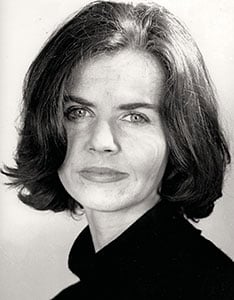
Beverly and I soon spent increasing amounts of time together, and at that time I also left Stockholm to move to Sweden’s second city, Gothenburg. The main reason for this was that my comfortable independent research position with the Swedish Medical Research Council had one main obligation; if a professorship became available in my field at one of the five Swedish universities, I was expected to apply. This rule of course made sense from the point of view of the Research Council, who expected their promising young scientists to move with the times. In consequence, when my formal application for a job in Gothenburg was approved I had no clear alternative, although I had lived and worked in Stockholm for most of my life. My department chairman in Gothenburg, Ulf Lagerkvist, was a delightful, helpful and highly cultured colleague. Soon after my move Beverly came to Gothenburg for a six month sabbatical (Fig. 10). She and her postdoc John Arrand had cloned the EBV genome as a set of large defined DNA fragments, and together with our Gothenburg colleague Lars Rymo we did some work on such DNA. Beverly was also in touch with her former mentor, Fred Sanger in Cambridge, and she persuaded him to sequence the entire EBV genome. It was the longest genome from any source that had been sequenced at that time, and became an important research tool.
In Stockholm, I recruited my first graduate students, who greatly contributed to the improving reputation of my research group; they were Stefan Söderhäll, Siv Ljungqvist and Marla Anvret. In Gothenburg I was then fortunate to receive several outstanding postdocs and sabbatical visitors who put the DNA repair aspect of the laboratory in international focus, including my future long-term collaborator Peter Karran. At that time, I was also pleased to be elected to EMBO, a helpful honour.
Move to Britain
While my work in Gothenburg was going well, Beverly and I had not resolved the problem of staying together in one place. But then I got a tentative offer from Sir Walter Bodmer, the Research Director of ICRF, to become head of a newly renovated laboratory building in outer north London, the Clare Hall Laboratories. This generous offer included not only excellent facilities and space for my own research group, but also the possibility to recruit and initially fund several new independent research groups to generate a critical mass. This position clearly surpassed my professorship in Gothenburg. So Beverly and I moved to a 300-year-old Georgian cottage in Highgate Village in north London, and she became a professor of virology at the Royal Postgraduate Medical School of Imperial College, London. I continued to work on both DNA repair and EBV, but because of increasing international competition in both fields and new exciting developments in the DNA repair field, I gradually scaled down my tumour virus work. After 35 years together with Beverly, she sadly became increasingly ill after a stroke, and she could not attend the Nobel festivities in Stockholm.
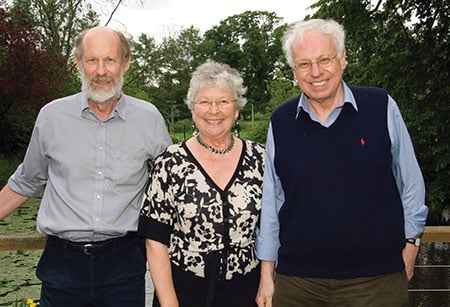
At the Clare Hall Laboratories, I was lucky to have two superb administrative co-workers: Frank Fitzjohn who managed the actual laboratories and Brenda Marriott who dealt with all staff problems (Fig. 11). They were responsible for the friendly and positive aspects of running the laboratories, which made these labs attractive to co-workers on all levels. The only problem with the Clare Hall Laboratories was that they were geographically somewhat remote from all the excitement in central London. But for a scientist who wanted to focus on his/ her research, it has had many advantages. A similar recent development appears to be the Janelia Farm outside Washington, DC, where hand-picked young scientists are offered generous support and facilities, and only nominal teaching obligations. At the Clare Hall Laboratories, we decided to focus on a limited number of overlapping research areas and attempted to become internationally top-class in these fields, which included DNA repair, DNA recombination, control of DNA replication, mutagenesis, and control of transcription. Among the most successful scientists on site were Steve West, David and Birgit Lane, John Diffley, Tim Hunt, Rick Wood and Jesper Svejstrup. In the summer of 2016, the scientists at the Clare Hall Laboratories, together with those at the Lincoln’s Inn Fields Laboratories (formerly ICRF) and those at the National Institute of Medical Research at Mill Hill in North London, are scheduled to move to a newly built large laboratory close to King’s Cross in Central London named the Francis Crick Institute, with Sir Paul Nurse as Director.
At the Clare Hall Laboratories, I continued my work on DNA repair mechanisms. The field had changed remarkably since I made my first studies in an unfashionable and underappreciated field, and it certainly helped the Clare Hall Laboratories that I was able to attract several prestigious sabbatical visitors and remarkable postdocs. These included Bruce Demple, Larry Grossman, Bob Painter, Phil Hanawalt, Errol Friedberg, Grigory Dianov, Claude Prigent, Primo Schär, Keith Caldecott, Arne Klungland and Yun-Gui Yang, and they were complemented by two excellent British senior staff members in my lab, Barbara Sedgwick and Deborah Barnes.
As in Stockholm, I depended greatly on outstanding technical staff, who included the eminent Peter Robins and a frequent visitor from the Gothenburg laboratory, Monica Olsson. Two influential short-term visitors and junior colleagues from Scandinavia were Erling Seeberg and Svante Pääbo. Erling was a brilliant Norwegian scientist who sadly died from cancer in his 50s, after having made key contributions in the early days of DNA repair. Whenever I felt a little isolated from mainstream research in Gothenburg, I thought of Erling who was worse off, since he initially had a very small and isolated lab outside Oslo. Svante applied the techniques of molecular genetics, and especially studies of DNA damage and repair, to create an entirely new research field, ancient DNA. And Svante and I shared some bête noires; he could not find any DNA at all in fossils many millions of years old, in spite of enthusiastic publications in the leading scientific journals, and my view was that the intrinsic instability of DNA made it impossible to isolate and sequence DNA from organisms as old as dinosaurs.
In 2005, at the age of 67, I had to step down from the position as Director of the Clare Hall Laboratories. John Diffley and Steve West ensured that topquality research would continue on site. Moreover, I continued as head of my own research group for another 4 years, but in 2009 I closed my “wet lab” at Clare Hall and concentrated on a scientific advisory role, both in Britain and at several places in continental Europe (including Sweden). One particularly interesting assignment was as Director of the Scientific Advisory Board of IFOM, the molecular oncology institute in Milan, Italy, where the Director, Marco Foiani, and I attempted to influence the emergence of IFOM as an internationally important research institution; in my opinion the best in Italy.
Perhaps in the near future I will have more time for gardening and playing the piano, but so far my retirement period has been as busy as before, which on balance is a good thing. I still hope to promote studies on one of the first mammalian DNA enzymes I found, the nuclear exonuclease Trex-1 (initially called DNase III). I remain convinced that this little-studied enzyme which removes unwanted single-stranded DNA fragments is a key to understanding autoimmunity and some serious inherited diseases in man. Time will tell if I am right or wrong.
In recent years I have received several treasured recognitions for my research work, especially in 2009 the French Prix Étranger of INSERM, in 2010 the Royal Medal of the Royal Society (London), and in 2013 the highest award of the Royal Society, which is their Copley Medal. I am particularly indebted to the Royal Swedish Academy of Sciences for awarding the 2015 Nobel Prize in Chemistry to myself, Paul Modrich and Aziz Sancar for our work on the chemistry of DNA repair. For me, it was a special honour to be the first Swede in over 60 years who has been awarded the Chemistry Prize. A field that started as a small speciality 45 years ago has achieved full maturity.
This autobiography/biography was written at the time of the award and later published in the book series Les Prix Nobel/ Nobel Lectures/The Nobel Prizes. The information is sometimes updated with an addendum submitted by the Laureate.
Addendum, January 2018
Tomas Robert Lindahl is a Swedish scientist specialising in DNA damage and repair. He was director of the Clare Hall Laboratories from 1986 to 2005 and has been awarded many prizes and awards for his work including the Nobel Prize for Chemistry, jointly awarded in 2015.
Tomas’ Mutagenesis Laboratory at Clare Hall characterised different DNA repair pathways in a long-term project to provide better understanding of the cellular defence mechanisms against damage to the human genome. Damaged sites in the chromosomal DNA can result in cell death or cancer, but may be corrected by DNA repair enzymes prior to phenotypic expression. The properties of several nuclear enzymes that remove harmful lesions or local aberrant structures from DNA have been investigated. The absence of such DNA repair factors may result in an increased frequency of malignant transformation or in some cases may be detected as immunological deficiencies.
Tomas closed his lab at the Clare Hall laboratories in 2009 but remains an Emeritus Group Leader at the Francis Crick Institute.
Nobel Prizes and laureates
Six prizes were awarded for achievements that have conferred the greatest benefit to humankind. The 12 laureates' work and discoveries range from proteins' structures and machine learning to fighting for a world free of nuclear weapons.
See them all presented here.
